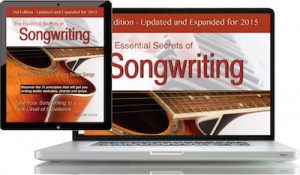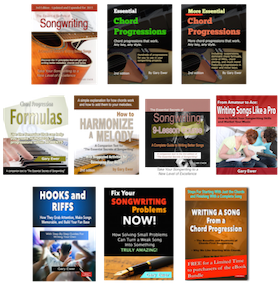For those of you who find setting lyrics to be the easy part, you can more or less ignore this post and go on with your regularly scheduled life. But if you find the whole issue of setting lyrics to music — especially with regard to rhythm and timing — to be one of the trickiest parts of songwriting, let’s look at some techniques and solutions to getting them working for you.
Let’s go on the assumption that you’ve got something already written, or perhaps you’re close enough to having something written that you need to start setting them to music. The two most common scenarios are:
- You’ve got a lyric, but no real idea for a melody.
- You’ve got a lyric, with a pretty good idea for a melody.
We’ll deal mainly with the first scenario: you’ve got a lyric, and now you need to write a melody to pair it up with. Of the many possible ways to proceed, here’s a set of steps you might want to consider:
1. Figure out the formal design of your song.
In other words, when you wrote your lyric, did you think of it in terms of verses and choruses? This is going to be important, because verse lyrics tend to be the descriptions of people and situations… the narrative. Chorus lyrics are usually the emotional responses. That’s also going to influence your melody as you write. So your first step is to make sure that you’ve got that part working properly.
2. Create a chord progression as a first step to melody writing.
Let’s create a chord progression that you can use as both your verse and chorus progression, going on the assumption that you’ll create a different melody for both sections. Here’s one to use if you can’t come up with something quickly: Am Em F G. Play through that progression several times and use different voicings. Different voicings will allow you to hear melodic possibilities.
 Lyrics and melodies are crucial partners to getting songs working. That’s Chapter 5 of “The Essential Secrets of Songwriting” eBook. To get today’s deal, visit the online store.
Lyrics and melodies are crucial partners to getting songs working. That’s Chapter 5 of “The Essential Secrets of Songwriting” eBook. To get today’s deal, visit the online store.
3. Find the innate rhythm of your lyric.
This is the step where you explore the rhythmic possibilities of your lyric. Follow the next few steps without worrying about things like specific timing or time signatures; just recite:
- Say your lyric over and over, and make mental note of where you place stresses and accents.
- Elongate the longer syllables, and place them higher in your voice as you read your lyric. You’ll hear the possibilities of melody begin to appear.
- Experiment by finding new ways to say your lyric. In other words, see what happens to the meaning of your text when you lengthen syllables that you formerly sang as short syllables. Example: “While your picture fades from my memory” might be read as “While your PIC – true FADES from my MEM-ory” with syllables in caps spoken as the longer ones, but could also be read as: “While YOUR picture FADES from MY mem-or-Y” Notice how the subtext (the implied meaning) of your words changes as you alter the rhythms.
You’ll notice that you start to get a sense of what you like in lyric delivery, and things will start to coalesce.
4. Find a time signature and place your words within.
Deciding on a time signature means to come to some understanding of the pattern of strong and weak beats. Here’s a procedure that will work:
- Tap your foot, maintaining a comfortable tempo — anywhere from 92 to 116 bpm. As you work on this, you may find yourself moving that tempo considerably faster or slower, depending on how you hear the song… uptempo or slower ballad, for example.
- Clap your hands on every second foot tap. That hand clap will signify a weak beat. That gives you a 4/4 (or “common time”) signature, the one that more than 90% of songs use.
- Find a way to say your lyric while keeping that strong beat-weak beat pattern going. Do this over and over; you may find that you’ll want to keep adjusting how words fit into that pattern.
- Consider 3/4 time (strong-weak-weak), especially if you find yourself struggling to make the lyric work in a strong-weak pattern. Clapping to 3/4 is trickier, as you may feel it as a strong foot tap followed by two weaker claps; or you may feel it as a clap on the strong beat, and then a clap on the 2nd of the two weak claps. It’s best not to overthink how you’re tapping/clapping.
5. Play your chord progression according to your time signature of choice.
Come up with a pattern of playing that supports the time signature you’ve chosen. Now it’s time to recite your lyrics again to this chord progression. Don’t worry about melody yet. Just play the chords and recite the words. This can take lots of experimenting. The final outcome you choose should always mean that most if not all of your words sound natural and effortless, with the pulses of the words falling naturally on the strong-weak patterns of your playing.
6. Begin to create a melody for your chorus.
As you do this step, keep the following in mind:
- Explore the upper regions of your vocal range.
- Place emotionally significant words highest in your melody.
- Make good use of repetition, and find opportunities to create a hook that will define your song. Find melodic ideas that will work on two or three of your chosen chords.
7. Create a melody for your verse.
Your verse needs to lead naturally into your chorus, and is usually lower in pitch than the chorus. So start low, find melodic ideas that sound good when they’re repeated, and always consider the rhythm of your words. Just as with the chorus, the pulse of the lyric needs to match the pulse of the music.
At this point, you’ve got the start of your lyric’s melodic treatment, and you’ve spent the most time thinking about how and where to place the words within the musical rhythms you’ve created.
Making sure that your words sound effective means paying close attention to the rhythm of the your lyric. That comes from saying your lyric many times, experimenting with the rhythms an timings of what you’re saying, before you even think about what the melody might be.
One way to use this method is to think about a song you really like, and then pretend that the writer used this method to create a melody for the lyric. So go ahead… Let’s say that your favourite song these days is Adele’s “Hello”. Read the lyric, and then go through each step, and see how the lyrics fit what would eventually become the melody.
 Written by Gary Ewer. Follow Gary on Twitter.
Written by Gary Ewer. Follow Gary on Twitter.
 “The Essential Secrets of Songwriting” is being used by thousands of songwriters to improve their technique and become better, more prolific writers. To see today’s deal, visit the online store.
“The Essential Secrets of Songwriting” is being used by thousands of songwriters to improve their technique and become better, more prolific writers. To see today’s deal, visit the online store.











Thanks for helping